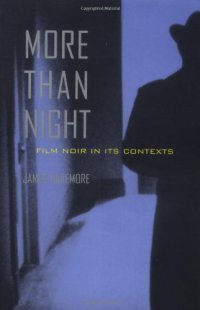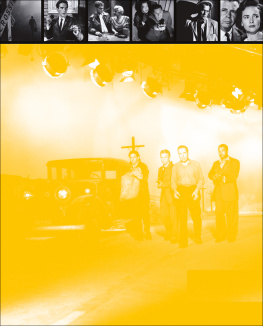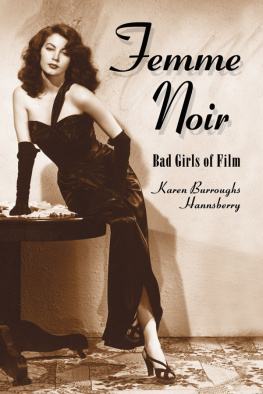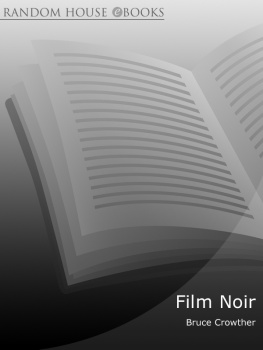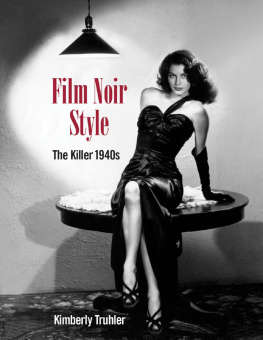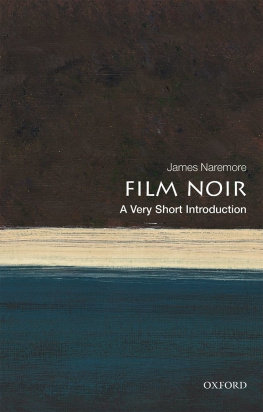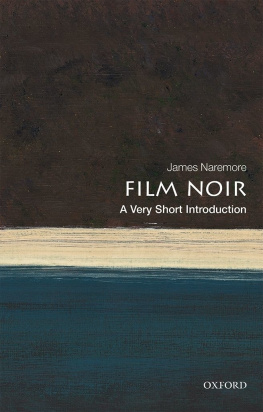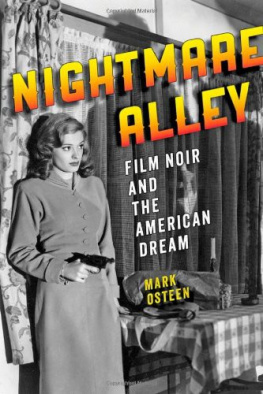James Naremore
More Than Night
Film Noir in Its Contexts
For Darlene, who made it possible;
for Alex, who may someday read it;
and in memory of Bernard Benstock,
mentor and friend,
who knew Double Indemnity by heart.
The streets were dark with something more than night.
Raymond Chandler, "The Simple Art of Murder," 1944
My work on this project was assisted by fellowships from the John Simon Guggenheim Foundation, the Center for Advanced Study in the Visual Arts at the National Gallery of Art, and the Office for Research and the Graduate School at Indiana University. Portions of the text, in somewhat different form, were originally published in Film Comment, Film Quarterly, and Iris: A Journal of Theory on Image and Sound. I am grateful to the editors of those journals Richard T. Jameson, Ann Martin, Janice Morgan, and Dudley Andrewfor their encouragement and wise suggestions. Several libraries also provided assistance. I am particularly indebted to Sam Gill and the staff at the Margaret Herrick Library of the Motion Picture Academy of Arts and Sciences and to the various professionals at the University of California, Los Angeles, Special Collections Department, the library of Congress, the Museum of Modern Art Stills Archive, and the Lilly Library. Five individuals were of special help, and I list them here in alphabetical order. Leo Braudy assured me from the beginning that I was on the right track and took me on a memorable tour of noir locales in Los Angeles. Dana Polan supported my proposal with his characteristic enthusiasm and generosity and offered many important suggestions for improving the final manuscript. Eric Rentschler wrote a careful and intelligent report on my first draft, helping me to see parts of it more clearly. Jonathan Rosenbaum was both my culture hero and my friend, reading parts of the work in progress and giving me the benefit of his astute critical perceptions and inexhaustible knowledge. Robert Stare praised my work throughout and was continually willing to write letters of recommendation.
Among my colleagues at Indiana University, Patrick Brantlinger and Barbara Klinger were strong intellectual influences, and I hope they will recognize how much I owe them. A number of people offered information or encouraged me through conversation and lettersespecially Christopher Anderson, David Anfam, Eva Cherniavsky, John Dyson, Jonathan Elmer, Tom Foster, Terry Hartnett, Joan Hawkins, D. K. Holm, Cimberli Kearns, Michael Morgan, Justus John Nieland, Mark Rappaport, Robert Ray, Teller, Franois Thomas, Alan Trachtenberg, and Peter Wollen.
I was unusually fortunate in having Edward Dimendberg as my editor at the University of California Press. Ed has written a great deal about film noir and will soon publish a book on the topic. I have never had an editor who was so informed and perceptive about my particular subject matter. Throughout, I was amazed by his broad knowledge of twentieth-century culture, his willingness to supply bibliographic information, and his close attention to details. He is certainly not responsible for my errors or misjudgments, but I would not have done as well without him. I am also indebted at the Press to Carolyn Hill and Scott Norton, who saw the book through production.
Finally, as always, I owe thanks to Darlene. J. Sadlier, who gave me moral support, companionship, and intelligent criticism, and who endured the whole process with remarkable gracein part, no doubt, because she likes film noir as much as I do.
Introduction:
This Is Where I Came In
When I was "at the cinema age" (it should be recognized that this age exists in lifeand that it passes) I never began by consulting the amusement pages to find out what film might chance to be the best, nor did I find our the time the film was to begin.
Andr Breton, "As in a Wood, " 1951
For most people, the term film noir conjures up a series of generic, stylistic, or fashionable traits from certain Hollywood pictures of the 1940s and 1950s. There are, for example, noir characters and stories (drifters attracted to beautiful women, private eyes hired by femmes fatales, criminal gangs attempting to pull off heists); noir plot structures (flashbacks, subjective narration); noir sets (urban diners, shabby offices, swank nightclubs); noir decorations (venetian blinds, neon lights, "modern" art); noir costumes (snap-brim hats, trenchcoats, shoulder pads); and noir accessories (cigarettes, cocktails, snub-nosed revolvers). There are also noir performances, often associated with the "radio voices" of actors like Alan Ladd and Dick Powell; noir musical styles, consisting not only of orchestral scores by Max Steiner, Bernard Herrmann, and David Raksin, but also of mournful jazz tunes, the essence of which have been captured on two retro albums made in the late 1980s and early 1990s by the Charlie Haden Quartet; and noir language, derived mainly from the hardboiled speech in Dashiell Hammett and Raymond Chandler. ("Is there any way to win?" Jane Greer asks Robert Mitchum in Out of the Past. "There's a way to lose more slowly," he replies.) To the informed tourist,
there are even real places, especially in Los Angeles, that seem bathed in the aura of noir: the Alto Nido residence hotel at Franklin and Ivar, just up the street from where Nathanael West wrote Day of the Locust; the Bradbury Building, featured in several movies and later chosen as the site of a P.E.N. ceremony honoring Billy Wilder; and most of all, the Glendale train station at night, looking much more colorful and charming than in Double Indemnity, where it was blacked out by wartime restrictions on lights.
These signs of film noir have influenced countless Hollywood directors of the poststudio era, who often recycle them or use them as a lexicon for parody and pastiche. Meanwhile, in the literature on movies, a slightly more complicated discourse on noir has grown steadily over the past three decades. Numerous books and essays have been written on the topic, usually analyzing thrillers or crime pictures of the 1940s and 1950s in terms of their cynical treatment of the American Dream, their complicated play with gender and sexuality, and their foregrounding of cinematic style. We might say, in fact, that film noir has become one of the dominant intellectual categories of the late twentieth century, operating across the entire cultural arena of art, popular memory, and criticism.
In the following book, I do not deny the importance or relevance of our culture's pervasive ideas about "noirness," but I treat the central term as a kind of mythology, problematizing it by placing the films, the memories, and the critical literature in a series of historical frames or contexts. One of the most important of these contexts, about which I say rather little in the book proper, is undoubtedly my own personal history, and I should perhaps acknowledge that determinant here at the beginning, before proceeding with my critical and scholarly concerns. The best place to start is in the mid to late 1950s, shortly before and during my adolescence, when the movies were still a relatively cheap form of entertainment. Television had not yet come to every household (my father purchased our first set around 1955), and most neighborhoods had second-run or rerelease theaters where the films changed every few days. At such places, moviegoing involved a feeling of circularity and flow; one often entered in the middle of a feature and then stayed to see the short subjects, the previews, and the opening one had missed. Even in the first-run venues at the heart of the city, it was not unusual to watch the show in a nonlinear or flashback style. Hence the popular expression, "This is where I came in."

